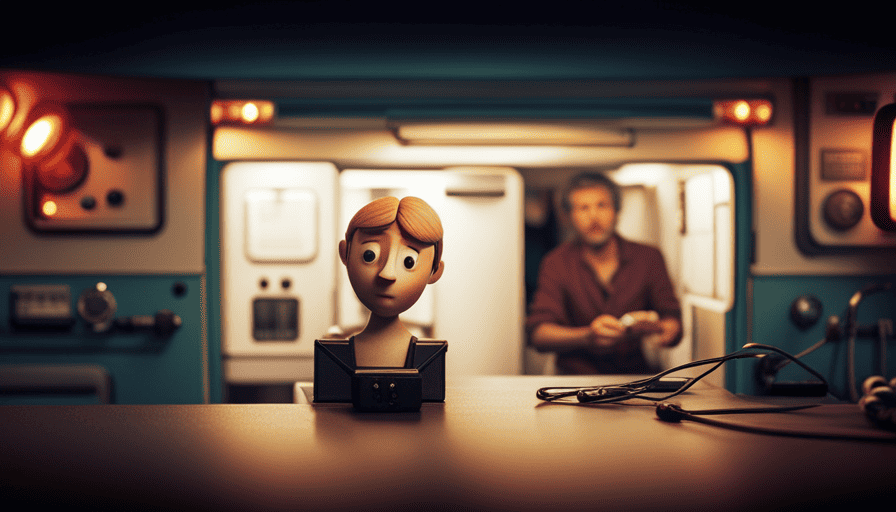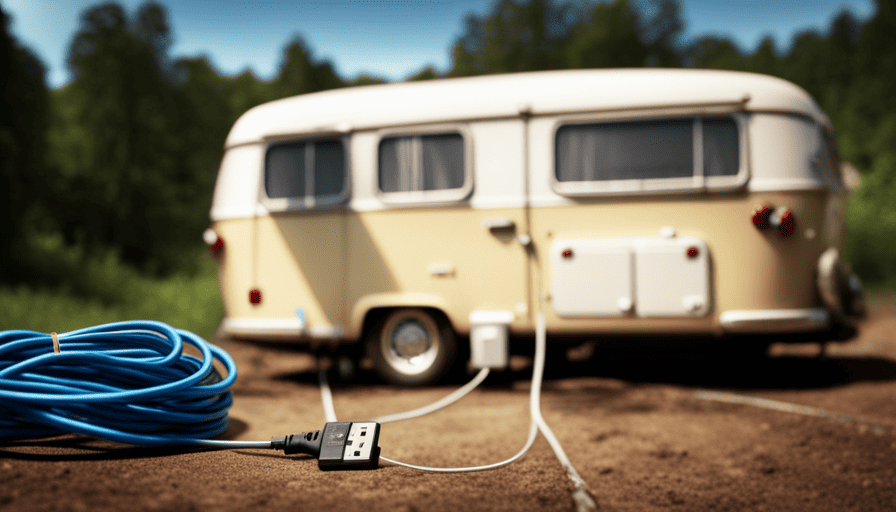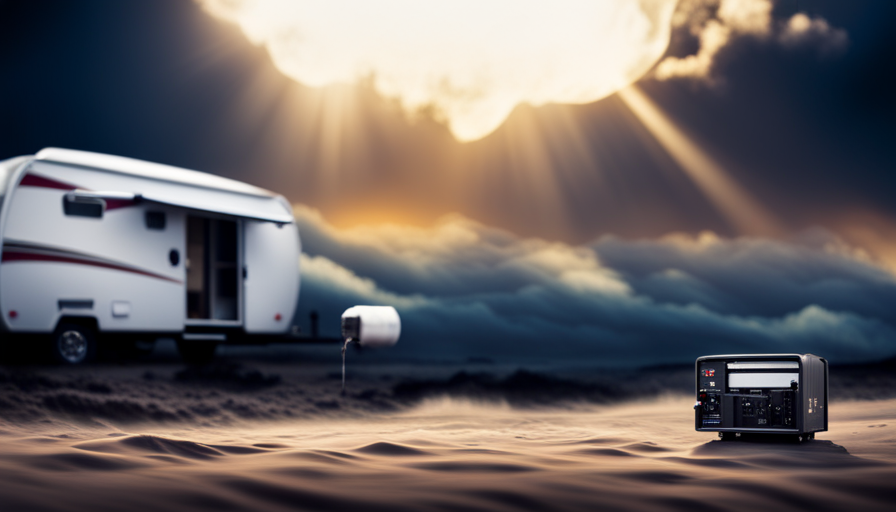Have you ever experienced the frustration of your camper lights refusing to illuminate when plugged in? It’s like being left in the dark, with no guidance or comfort.
But fear not, for I have the solution to your problem. In this article, I will guide you through a series of steps to diagnose and fix the issue, ensuring that your camper lights shine bright once again.
We will delve into the intricacies of the power source, inspect the light bulbs, test the fuse, examine the wiring connections, look for any damaged wiring, test the voltage, inspect the circuit breaker, consult the owner’s manual, and if all else fails, seek professional help.
By following these precise and technical steps, you will regain the luminosity that your camper lights once provided, banishing the darkness and restoring a sense of warmth and security to your camping experience.
By examining the circuit breaker and ensuring it is not tripped, you can determine if it is the cause of the camper lights not working when plugged in. If the issue persists, referring to the owner’s manual will provide more detailed instructions on resolving the problem.
Key Takeaways
- Verify power source for correct voltage and any damage or faults.
- Inspect light bulbs for damage or loose connections.
- Test fuse in camper’s electrical system for continuity and replace blown fuses with ones of the same amperage rating.
- Inspect and troubleshoot circuit breaker panel in camper if necessary.
Check the Power Source
Is your camper’s power source causing the lights to malfunction when plugged in? If so, there are a couple of things you can do to troubleshoot the issue. First, verify the power outlet that you’re using. Make sure it’s supplying the correct voltage and that it’s not damaged or faulty. You can do this by using a voltage tester or plugging in another device to see if it works properly. Next, check the power cord of your camper. Inspect it for any visible damage, such as frayed wires or loose connections. If you notice any issues, it may be necessary to replace the cord. Additionally, make sure the cord is securely plugged into the power source and the camper itself. By verifying the power outlet and troubleshooting the power cord, you can determine if the power source is the cause of the lights not working. Once you’ve ruled out these possibilities, you can move on to inspecting the light bulbs to see if they’re the problem.Inspect the Light Bulbs
Check if you’ve got any spare bulbs, so you can quickly replace them and get your camper brightly lit again. When troubleshooting camper lights not working when plugged in, it’s important to inspect the light bulbs for any common issues. Start by turning off the power source and removing the light bulb from its socket. Carefully examine the bulb for any signs of damage such as a broken filament or blackened areas. If you notice any issues, it’s recommended to replace the bulb with a new one that matches the specifications of the previous bulb. In addition to physical damage, another common issue with light bulbs is loose connections. Ensure that the bulb is securely screwed into the socket and that the contacts are clean and free from corrosion. If there is corrosion present, use a small brush or sandpaper to gently clean the contacts before reinserting the bulb. Testing the fuse is the next step in troubleshooting your camper lights.Test the Fuse
After inspecting the light bulbs for any damage or loose connections, the next step is to test the fuse. The fuse is a crucial component in the camper’s electrical system, as it protects the lights from power surges and short circuits. Here are some troubleshooting tips and common issues to consider when testing the fuse:- Check the fuse box: Locate the fuse box in your camper, usually found near the main electrical panel. Open the fuse box and visually inspect the fuses for any signs of damage or discoloration.
- Test the fuse with a multimeter: Set the multimeter to the continuity mode and touch the probes to both ends of the fuse. If the multimeter beeps or shows a low resistance reading, the fuse is intact. If there is no continuity, the fuse is blown and needs to be replaced.
- Replace the fuse: If the fuse is blown, carefully remove it from the fuse box and replace it with a new one of the same amperage rating.
Examine the Wiring Connections
Take a moment to marvel at the intricate web of wiring connections that bring illumination and power to your cozy camper. As we continue our troubleshooting steps, we now turn our attention to examining the wiring connections. This is a crucial step in identifying and resolving common camper light problems. Start by visually inspecting all the wiring connections in the camper. Look for any loose or disconnected wires, as these can cause your camper lights to malfunction. Ensure that all connections are secure and properly attached to their respective terminals. Pay close attention to any signs of corrosion or damage, as these can also affect the functionality of your camper lights. Next, use a multimeter to test the voltage at each connection point. Set the multimeter to the appropriate voltage range and carefully probe each wire connection. Compare the readings to the manufacturer’s specifications to determine if the voltage is within the expected range. Any significant deviations may indicate a faulty connection or wiring issue. If you notice any damaged wiring during your inspection, such as frayed or exposed wires, this could be the source of your camper light problem. Damaged wiring can cause short circuits or interruptions in the electrical flow, leading to lights not working. In the next section, we will further explore how to look for damaged wiring and address this issue. Continue troubleshooting by examining the wiring connections and look for damaged wiring that may be causing your camper lights to malfunction.Look for Damaged Wiring
Inspect the wiring connections closely for any signs of frayed or exposed wires, as these can cause interruptions in the electrical flow and lead to issues with your camper’s lighting system. To ensure a thorough examination, follow these steps:- Check for loose connections: Gently tug on each wire to ensure it’s securely attached to its corresponding terminal. If any wires feel loose, tighten the connections using a screwdriver or pliers.
- Test the power cord: Plug the camper into a power source and use a multimeter to check for voltage at the end of the power cord. If there’s no voltage, the power cord may be damaged and needs replacement.
- Inspect the wiring harness: Carefully examine the entire length of the wiring harness for any signs of damage, such as cuts or frayed insulation. If any damage is found, the affected section should be replaced to prevent further issues.
- Look for damaged wiring: Inspect each wire for any visible damage, such as exposed copper or melted insulation. If damaged wiring is discovered, it should be repaired or replaced to ensure proper electrical flow.
Check the Light Switches
Make sure you check if the light switches are functioning properly. When troubleshooting camper lights that aren’t working when plugged in, it’s important to inspect the light switches for any common issues. Start by turning the light switch on and off multiple times to see if the lights flicker or if there’s any loose connection. If you notice any flickering or if the lights don’t turn on at all, it could indicate a faulty switch. In some cases, the switch may need to be replaced. Another common issue with light switches is loose or damaged wiring connections. Carefully inspect the switch and surrounding wiring for any signs of wear, fraying, or loose connections. If you find any damaged wiring, it’ll need to be repaired or replaced. It’s also a good idea to check if the light switch is properly grounded, as improper grounding can cause issues with the lights. Once you’ve checked the light switches, the next step is to test the voltage to further troubleshoot the problem.Test the Voltage
To get a shockingly accurate diagnosis, you’ll need to test the voltage in your camper. Voltage fluctuations can be a common cause for camper lights not working when plugged in. These fluctuations can occur due to various factors, such as power surges or faulty electrical connections. Testing the voltage will help determine if there’s a problem with the power supply to your camper lights. To begin, you’ll need a multimeter, which is a device used to measure voltage. Start by turning off all the lights in your camper and unplugging any devices that are connected to the electrical system. Then, locate the power source and plug in your camper. Set the multimeter to the voltage setting and insert the probe into the power source. Take note of the reading displayed on the multimeter. A stable voltage reading within the accepted range indicates that the power supply is functioning properly. However, if you notice any significant voltage fluctuations or power surges, it may indicate an issue with the electrical system. In this case, it’s recommended to inspect the circuit breaker to further investigate the problem. Moving on to the next step, we’ll inspect the circuit breaker to ensure it’s not tripped or malfunctioning.Inspect the Circuit Breaker
Take a moment to check the circuit breaker in your camper, ensuring it is in proper working condition. The circuit breaker is a crucial component of the camper’s electrical system as it protects the wiring from overloading and potential damage. To inspect the circuit breaker, follow these steps:| Step 1 | Locate the circuit breaker panel in your camper. It is usually found near the electrical outlet or in a designated area. | Step 2 | Open the panel cover by gently pulling it towards you or unscrewing the fasteners, depending on the model. |
| Step 3 | Check if any of the circuit breakers have tripped. A tripped breaker will be in the “off” position or halfway between “on” and “off”. | Step 4 | If you find a tripped breaker, reset it by flipping it to the “off” position and then back to the “on” position. |
| Step 5 | Once all breakers are in the “on” position, check the electrical outlet to confirm if the camper lights are functioning properly. | Step 6 | If the lights are still not working, consult the owner’s manual for further troubleshooting steps. |
Consult the Owner’s Manual
Refer to the owner’s manual for more information on troubleshooting the issue with your camper’s electrical system. Troubleshooting common electrical issues is crucial to identifying and resolving problems with your camper lights. Understanding camper lighting systems is essential for efficient troubleshooting. First, ensure that the lights are properly connected to the power source. Check the owner’s manual for the specific wiring diagram and follow it carefully. If the lights are properly connected, proceed to inspect the bulbs. Replace any burnt-out bulbs with new ones of the correct wattage and type. If the bulbs aren’t the issue, examine the fuses in the camper’s electrical panel. The owner’s manual should provide guidance on locating the panel and identifying the specific fuses for the lights. Replace any blown fuses with ones of the same rating. If these steps don’t resolve the problem, it’s advisable to seek professional help. A certified electrician or camper technician can perform more advanced diagnostics and repairs to ensure the electrical system is functioning correctly. Transitioning into the next section, seeking professional assistance can save time and ensure the safety of your camper’s electrical system.Seek Professional Help
If you’re in a bind and need expert assistance, don’t hesitate to call a certified electrician or camper technician who can work their magic and ensure your camper’s electrical system shines bright like a starry night. When it comes to potential electrical issues with camper lights not working when plugged in, troubleshooting can be a daunting task. However, with the right approach, you can identify and resolve the problem. Here are some troubleshooting tips to consider:- Check the power source: Ensure that the camper is properly connected to a reliable power source, such as a campground pedestal or a generator. Faulty or inadequate power supply can cause lights to malfunction.
- Inspect the fuses: Locate the fuse box in your camper and check if any of the fuses related to the lights have blown. Replace any blown fuses with ones that have the correct rating.
- Test the bulbs: Remove the light bulbs from the fixtures and test them using a multimeter or by replacing them with known working bulbs to ensure they’re not the cause of the issue.
- Examine the wiring: Inspect the wiring connections for any loose or damaged wires. Tighten any loose connections and repair or replace any damaged wiring as necessary.
- Seek professional help: If you’re unable to identify or resolve the issue, it’s best to seek professional help from a certified electrician or camper technician who can diagnose and fix the problem accurately.
Frequently Asked Questions
How can I determine if the power source is the issue when my camper lights are not working?
To troubleshoot power issues in a camper and determine if the power source is the problem, follow these steps. First, check the circuit breaker panel to ensure all breakers are in the ‘On’ position. If that doesn’t solve the issue, use a multimeter to test the power outlet for voltage. If there is no power, try plugging in another device to confirm. If the power source is faulty, consult a professional electrician to resolve the problem.What steps should I take to inspect the light bulbs when my camper lights are not working?
To inspect the light bulbs in my camper when they’re not working, I’ll follow these troubleshooting techniques. First, I’ll turn off the power and remove the bulb from the socket. Next, I’ll visually inspect the bulb for any signs of damage or a burnt-out filament. If the bulb looks good, I’ll use a multimeter to test for continuity. If the bulb is faulty, I’ll replace it with a new one. These common light bulb issues can often be easily resolved through careful inspection and replacement.How do I test the fuse when my camper lights are not working?
To test the fuse in my camper lights, I first need to locate the fuse box. Once I find it, I’ll inspect the fuse for any signs of damage or a blown fuse. Using a multimeter, I’ll check the continuity of the fuse to see if it’s working properly. Additionally, I’ll test the battery to make sure it has enough power. I’ll also check the circuit breaker for any tripped switches.What should I do to examine the wiring connections when my camper lights are not working?
To examine the wiring connections when camper lights aren’t working, first check for possible causes such as loose or damaged connections. Begin troubleshooting by disconnecting the power source and ensuring the lights are off. Then, inspect the wiring connections for any signs of corrosion, fraying, or loose connections. Carefully tighten any loose connections and replace any damaged wiring. Reconnect the power source and test the lights to see if the issue has been resolved.How can I identify damaged wiring as the cause of my camper lights not working?
To identify damaged wiring as the cause of my camper lights not working, I need to look for common signs of damaged wiring in the camper’s electrical system. These signs include frayed or exposed wires, burn marks, loose connections, and melted insulation. To troubleshoot and repair the damaged wiring, I should first turn off the power supply. Then, I can carefully inspect the wiring, replacing any damaged sections and ensuring all connections are secure. Finally, I can test the lights to ensure they’re functioning properly.Why Do Camper Lights Dim When Plugged In?
When campers plug in their electrical systems, they may notice a decrease in the brightness of their camper lights once connected. This decrease in brightness is caused by a voltage drop. As electricity travels through wires, the length and resistance of the wire can lead to a reduction in voltage, resulting in dimmer lights. To address this issue, using shorter wires and bulbs that can handle higher voltages could help alleviate the problem.



















